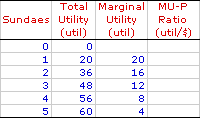The marginal utility-price ratio indicates the satisfaction derived from the last dollar spent on a good. A consumer maximizes utility be equating the marginal utility-price ratio for each good purchased and consumed. If the ratios are not equal, then utility can be increased by changing the combination of goods consumed.A generic marginal utility-price ratio looks like this:
marginal utility of a generic good
price of a generic good |
| Duncan Buys Some Sundaes |  |
Consider a few numbers from the table to the right to provide a little insight into the marginal utility-price ratio. These numbers represent the total utility and marginal utility obtained by Duncan Thurly for consuming Hot Momma Fudge Bananarama Ice Cream Sundaes.In total utility terms, Duncan receives 20 utils of satisfaction for one sundae, 36 utils for two sundaes, 48 utils for three sundaes, etc. The marginal utility for the first sundae is therefore 20 utils, for the second sundae it is 16 utils, for the third it is 12 utils, etc. Note that the price of each Hot Momma Fudge Bananarama Ice Cream Sundae is $4.
The marginal utility-price ratio is calculated by dividing the marginal utility in the third column by the sundae price of $4. The first sundae has a marginal utility of 20 utils, giving a marginal utility-price ratio of 20 utils divided by $4, or 5 utils per dollar.
marginal utility of hot fudge sundaes
price of hot fudge sundaes | = | 10 utils
$4 | = | 5 utils per dollar |
The second sundae has a marginal utility of 16 utils, giving a marginal utility-price ratio of 16 utils divided by $4, or 4 utils per dollar, calculated in the same way. Click the button labeled [Ratios] to reveal ratios for each of the sundaes.Of what possible use are the marginal-utility price ratios in the fourth column of this table? They are critical to Duncan Thurly's sundae-buying decision. Because the first Hot Momma Fudge Bananarama Ice Cream Sundae generates 20 utils of satisfaction at a $4 price, each dollar Duncan spends is responsible for 5 utils of satisfaction. That is what the 5 utils per dollar number means.
However, dropping down the table, the fifth Hot Momma Fudge Bananarama Ice Cream Sundae generates only 4 utils of satisfaction, meaning that each dollar Duncan spends is responsible for 1 util of satisfaction. Because marginal utility declines with additional consumption, due to the law of diminishing marginal utility, the satisfaction per dollar also declines.
How many Hot Momma Fudge Bananarama Ice Cream Sundaes should Duncan buy? One? Five? Three? The answer depends on alternative purchases that Duncan could make--especially the marginal utility-price ratios of those alternative purchases. If alternative purchases have marginal utility-price ratios of 5 utils per dollar, then Duncan buys one sundae and no more. Why buy the second sundae with a marginal utility-price ratio of 4 utils per dollar when every other purchase, every other alternative, comes in at 5 utils per dollar.
If, however, alternative purchases have marginal utility-price ratios of 1 util per dollar, then Duncan can go nuts buying four Hot Momma Fudge Bananarama Ice Cream Sundaes, because every sundae up to and including the fifth has a marginal utility-price ratio equal to or greater than 1 utils per dollar. Duncan has no alternative purchases that generate as much utility per dollar as these five hot fudge sundaes.
MARGINAL UTILITY-PRICE RATIO, AmosWEB Encyclonomic WEB*pedia, http://www.AmosWEB.com, AmosWEB LLC, 2000-2025. [Accessed: July 1, 2025].


